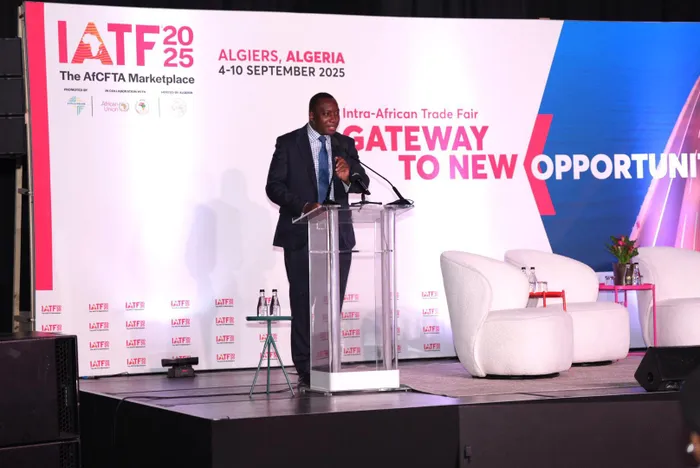Afreximbank to boost intra-African trade with new Nigeria-Namibia shipping route
INTRA-AFRICA TRADE

Afreximbank's director for trade facilitation and investment promotion, Dr Gainmore Zanamwe, on Thursday speaking at the Inter-African Trade Fair (IATF) 2025 Business Roadshow in Johannesburg ahead of the 4th IATF which will take place in Algeria in September.
Image: Supplied
The African Export-Import Bank (Afreximbank) has announced that it will be establishing a new shipping route on the western coast of the continent among a plethora of measures aimed to facilitate the movements of goods between Namibia and Nigeria and boost intra-Africa trade.
This comes as intra-African trade still remains very low at around 15% to 18% compared to nearly 70% in the European Union and around 50% in Asia.
Afreximbank's director for trade facilitation and investment promotion, Dr Gainmore Zanamwe, on Thursday said the continent was now in a good place to actually see a rapid increase in intra-African trade with the full operationalisation of the African Continental Free Trade Area Agreement (AfCFTA).
Zanamwe said the Afreximbank has been putting in place a number of interventions that are breaking the barriers that are affecting intra-African trade.
He said the Afreximbank has established a continental trading company, the Africa Trade and Distribution Company, to provide market intelligence and aggregate products since logistics is one of the major challenges facing the continent.
“The Africa Trade and Distribution Company is going to help us to actually aggregate goods that are produced by SMEs, informal sectors, and smallholder farmers, to take them to the market. With all these interventions, they will actually contribute towards increasing intra-African trade.
“We also use the same entity, for example, to distribute some of the products that are being produced by the Dangote Refinery. You may be aware that we, at Afreximbank, actually financed that refinery and now there's a production of fuel, fertilizer and other products. So using the trading company, we can actually distribute those products to Southern Africa.
“We are going to create a new shipping route which will take products from Dangote [Refinery] in Nigeria all the way to Walvis Bay and that creates a new route which will facilitate intra-African trade. So we have put in place very solid interventions that will help us to increase or boost intra-African trade.”
Zanamwe was speaking after making a presentation at the Inter-African Trade Fair (IATF) 2025 Business Roadshow in Johannesburg ahead of the 4th IATF which will take place in Algeria in September.
He said since the Afreximbank introduced a dedicated focus, intra-Africa trade now contributes more than 30% as a share of its total finance portfolio whereas it contributed less than 3% before 2018.
According to Zanamwe, Afreximbank has managed to finance more than $20 billion of inter-African trade during the first strategic plan, which ended in 2021.
He said from 2022 to 2026, the bank’s second strategic plan, Afreximbank was planning to finance $40bn in terms of inter-African trade and it was already on its way to actually exceed that target.
“We are sick and tired of exporting jobs and income. At Afreximbank we believe that we have the finance, we have the skills, we have the resources, we need to focus on industrialization,” Zanamwe said.
“We should stop the many thousands of journeys that are being undertaken by ships that are carrying our minerals, where our minerals are being validated outside the continent. We really need to put a stop to that and ensure that the minerals are beneficiated at source and we develop the local communities.”
As an illustration of this, Afreximbank’s chief economist and managing director for research, Dr Yemi Kale, said Tunisia, Morocco, and South Africa collectively imported more than $400 million worth of leather annually, primarily from Europe and South America, even though countries like Ethiopia, Kenya, and Sudan possessed both the capacity and the quality to supply a significant portion of that leather.
“So the problem here is not capacity. The problem is connectivity. The problem is lack of connectivity,” Kale said.
“Similarly, West African countries spend over $3bn annually importing meat products from countries that are listed as Argentina and Australia while nations such as Mali, Namibia, Chad, Sudan, Botswana, South Africa, and Zanzibar have the production capacity to meet most of this demand.
“This country is at the center of Africa's integration agenda. South Africa has the economic foundations, entrepreneurial spirit, and institutional strength to lead by example. With a growing manufacturing base, a strong agricultural sector and a dynamic SME ecosystem, South Africa is well positioned to integrate into the regional value chain, expand its exports value added, and attract investment from across the continent.”
BUSINESS REPORT